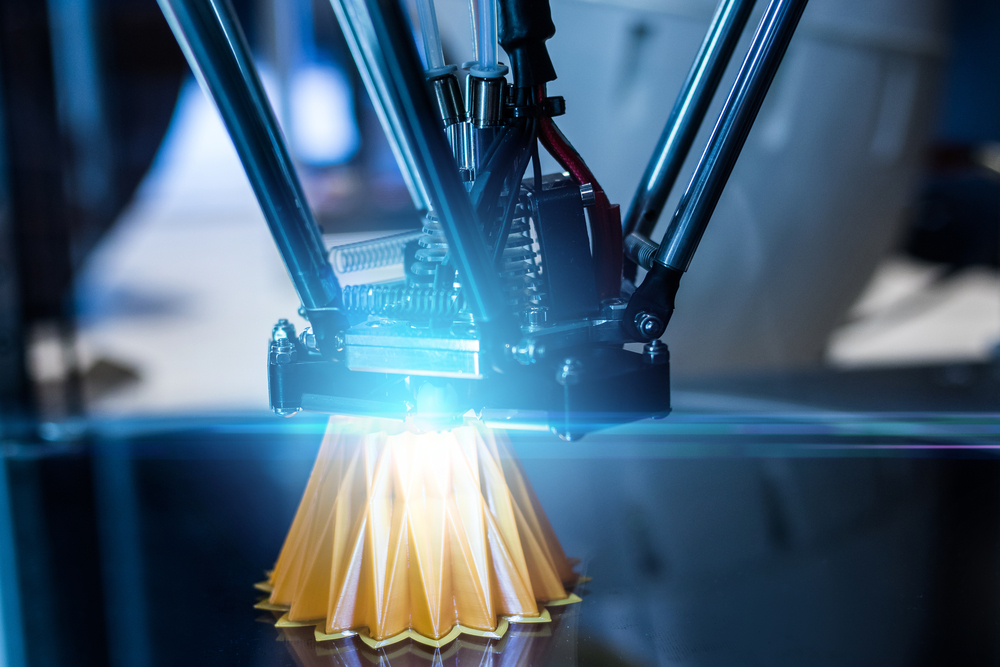
Additive Manufacturing Process Overview (With Examples)
3D printing or additive manufacturing is transforming the manufacturing sector. The technology simplifies the manufacturing process by eliminating tooling and enabling production using a wide range of materials. The cost-efficiency and speed of the process in terms of designing, prototyping, testing, and full-scale production enables manufacturers to take a flexible, on-demand, and sustainable manufacturing approach with accelerated time-to-market.
However, 3D printers are still seen more as a means to create prototypes and not as a solution for high-volume production or manufacturing of finished products. Let’s look at some additive manufacturing process examples in the pharmaceutical, toy manufacturing, HVAC, and footwear industries that highlight the feasibility of 3D printing for high-volume production.

Additive Manufacturing Process Example in the Pharmaceutical Sector
Bioreactors play a critical role in producing pharmaceuticals, antibodies, and vaccines. The vessels are designed to control several internal environmental factors, including temperature, pH, dissolved gasses, nutrient concentrations, and others. Additive manufacturing has played a significant role in speeding up the development of bioreactor systems. One such example is the development of an impeller for a bioreactor. Typical impeller development relies on using computational fluid dynamics (CFD) to simulate the effects in the fluid. Because of the complexity of the model, the CFD takes a very long time (48 hours or more). Utilizing 3D printing for prototyping allows for rapid production of an impeller that can be placed into operation in a system and tested before the CFD work is completed.
Additive manufacturing allows manufacturers to test prototype designs within a day while making minor adjustments. The iteration process speeds up rapidly, making it possible to implement as high as 30 iterations in a month. The quick iterations greatly improve the overall design of bioreactors and speed up the product development process by 30-50%.
Advanced and versatile 3D printing materials such as Polycarbonate (PC), Ultem 1010, and Acrylonitrile Butadiene Styrene (ABS) offer durability, stability, and accuracy for prototyping and ancillary parts. Ultem 1010, one of the strongest FDM thermoplastics, displays high heat, chemical resistance, and thermal stability — the unique characteristics that allow for contact with process fluids and other chemicals. The material properties can compete with conventional stainless steel materials to withstand sterilization, composite fabrication, and cell growth operations.
Additive Manufacturing Process Example in the Toy Sector
3D printing in the toy sector has made it possible for designers (including kids) to create and print their own sets of toys. Objects can be drawn, or 3D files designed elsewhere can be imported to create custom printable CAD designs. By deploying the additive manufacturing process, rigid or elastic toys or even interactive toys such as Water Constructor — a DIY set of sprinkler systems can be easily printed. For startup toy manufacturing companies, creating prototypes incurs huge costs. With low risks and costs, 3D printing makes it easy for startups to build their businesses in the toy sector. Manufacturers can quickly get customer feedback on prototypes, develop custom toy designs, and increase production capacity without additional capital investments.
Additive Manufacturing Process Examples in the HVAC Industry
In the HVAC sector, additive manufacturing process examples include printing components such as plastic parts of indoor fan coil, enclosure for the printed circuit boards (PCBs), centrifugal fans, cross blow fan, and even 3D printing the entire AC unit. Unlike traditional manufacturing methods that yield standard models of AC units, industrial 3D printers enable customizing the outlook of AC units as per the functional and aesthetic needs of customers. Specific features can be integrated into the unit, such as personalized control panels with different options for airflow, facing, and efficiency.
Additive Manufacturing Process Examples in the Footwear Industry
Traditional footwear production demands a large workforce, with each component produced individually through the high-cost injection molding process. The conventional uppers are made by cutting the textiles and assembling the pieces through gluing and stitching, while high-performance midsoles are designed with multiple materials but have life and compression set limitations. In additive manufacturing of footwear with LuxCreo’s high-performance materials, midsole components are consolidated into one CAD model with generativity-designed lattice structures to achieve the required performance in a single piece. The 3D-printed lattice structures made of high-performance, elastic resins such as EM+23 provide higher performance, greater comfort, and longer life than comparable foam midsoles.
Advanced customized footwear applications also benefit from additive manufacturing processes. Custom shoe insoles, including medical insoles, can be defined with the help of app-based digital scans and digitalized and automated design workflows combined with additive manufacturing. High performance is achieved with desired weight, thickness, and material flexibility and support can be tuned for specific sport and athlete biomechanical requirements. Custom outsoles require developing costly molds for each variation and hours of tooling, which eventually limits the scope of outsole alterations made with traditional manufacturing methods. By eliminating the need for tooling, 3D printers produce outsoles for custom sports applications, athletic abilities, shoe sizes, and types without requiring additional time or tooling cost.
For manufacturing companies, industrial Smart Factory 3D printers can transform the entire prototype-to-production process. The production agility and design flexibility of the additive manufacturing process can be further improved by partnering with Smart Factory 3D printer providers. With a local cloud-connected Smart Factory, manufacturers can create a sustainable, fast, on-demand, and cost-efficient production line across industries and applications.
LuxCreo offers integrated and advanced Smart Factory 3D printing solutions and on-demand Smart Factory production services to simplify manufacturing and improve manufacturing sustainability. Whether you are developing next-generation innovative products or want to scale up production, LuxCreo provides a Smart Factory additive manufacturing platform that helps you deliver your innovations to market faster and more cost-effectively than traditional and legacy 3D printing solutions. To learn more about Smart Factory additive manufacturing process examples for high-volume contract manufacturing, visit our contact page or call (650) 336-0888.

